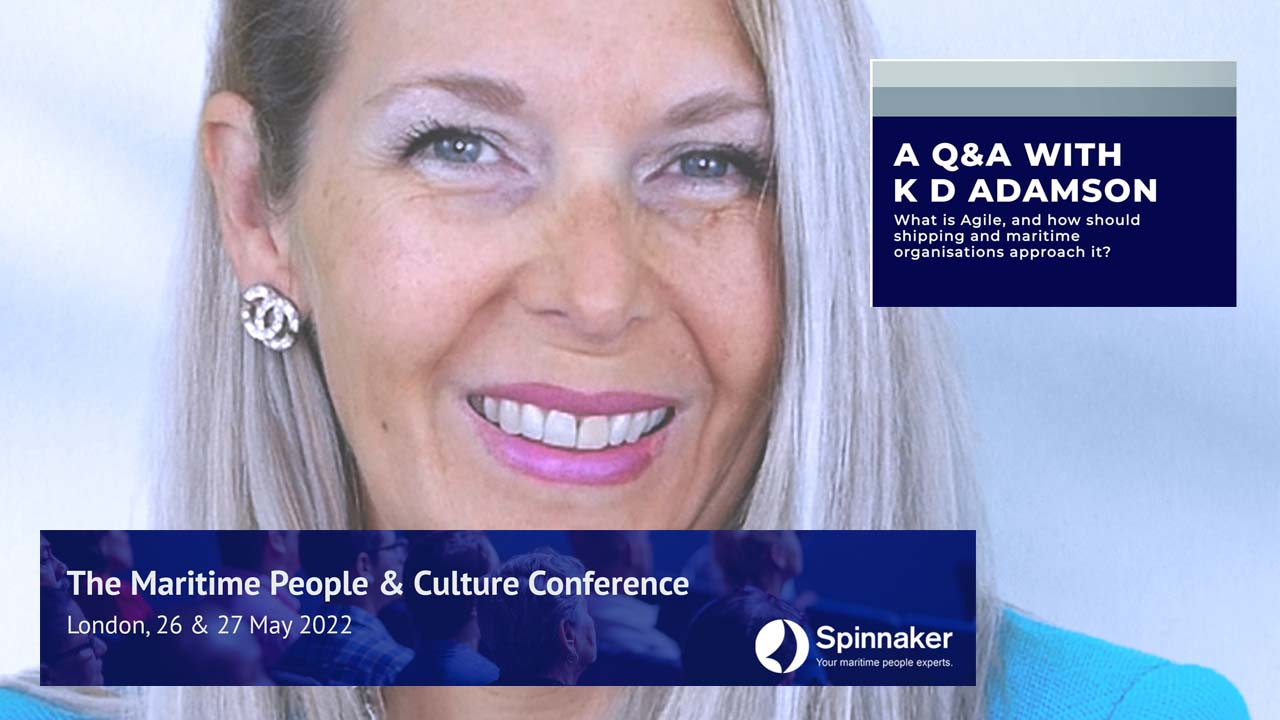Changing Course
Share this blog
Latest Maritime Vacancies
Client Executive
Technical Superintendent (Dry) – Europe
Tanker Technical Superintendent – Europe
HSSEQ Superintendent – Europe
Fleet Manager (Dry) – Europe
What does agile really mean and how should the shipping and maritime industry approach it? A Q&A with K D Adamson

Ahead of the 2022 Spinnaker Maritime People & Culture Conference we sat down with our keynote and special guest, shipping’s most famous futurist, K D Adamson.
One of the most sought-after futurist speakers globally K D Adamson’s keynotes have been likened to a TED talk on steroids.
With a stellar client list K D has advised organisations in multiple industries from the largest companies to start-ups, and is expert in ESG, agility, leadership, technology, digital and organisational transformation, and the Blue, Green and Circular Economies.
As the world’s foremost maritime futurist her client list spans the ocean industries, and she is renowned for combining visionary thinking, foresight and insight with sharp, straight-talking commercial and business acumen & expertise.
As futurist-in-residence at Futurenautics she works with ship owners, operators & managers, maritime suppliers, policymakers, regulators, technology companies, charities, class, NGOs, banks, VC, port and logistics groups.
In the third part of our conversation, we asked her to explain what agile really means, and how the shipping and maritime industry should approach it.
K D Adamson: For a lot of people agile at the moment is shorthand for flexible working, and of course the pandemic has focussed everyone on how you keep an organisation going which has traditionally depended on in-person interaction, when you can no longer have that physical interaction.
But agile is actually far deeper than that. It originally came out of software development, the agile manifesto which says that
We value individuals and interactions over processes and tools,
We value working software over comprehensive documentation,
We value customer collaboration over contract negotiation and
We value responding to change over following a plan
So this is about fundamentally changing not where we work, but the way that we work. Of course the agile manifesto was just based around software development, but enterprise agility, business agility is really about adaptability. Agility means creating the environment, capability and culture that motivates people and organisations to continuously and rapidly respond to challenges and opportunities by working, thinking, innovating and operating in agile ways. It’s about rewiring organisations and mindsets and ultimately wider value chains and ecosystems.
A truly agile organisation can seamlessly redirect its people, its budgets and its priorities towards value-creating opportunities, and respond to dynamic enterprise risk. At the heart of this are small, cross-functional, autonomous teams with the power and the authority to solve problems, usually customer-focussed ones. These teams rely on trust-based relationships rather than traditional hierarchy, which of course by extension throws up some big changes in the way that we lead and manage companies too.
Agile organisations have to be purpose-led, because when you get rid of hierarchy, you need strong cultural alignment to replace it. And that is dependent upon a core organisational vision and purpose, which is clearly communicated and continually reinforced, so that it provides a shared language across the organisation.
So for any shipping and maritime company exploring agile I would encourage them to start there. To find and articulate that North Star purpose which will enable you to move from the business from a command and control hierarchy, to a convene and catalyse network which allows you to adapt really quickly to changing conditions.
You can watch the video to accompany this interview with K D Adamson by following this link
The conference takes place on Thursday 26th & Friday 27th May in the City of London, so follow this link now to view the full agenda and book tickets.